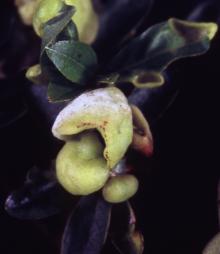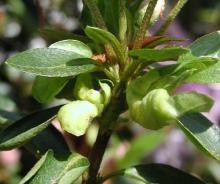See:
Cause Exobasidium vaccinii, a fungus that is believed to overwinter as spores adhering to bark and bud scales and to cause infection with the opening of buds in spring. Older leaves are resistant to infection. Infection is dependent on high humidity and moisture during bud break. Gall growth is due to plant cell division resulting from the stimulus of hyphal growth within host tissue. When galls are still soft, the fungus grows between epidermal cells, breaks the cuticle, and sporulates giving the gall a white cast. Diseased inflorescences of Rhododendron calendulaceum (flame azalea) produced fewer flowers, smaller individual flowers, and had a lower probability of producing fruit. Diseased branches were more likely to die the following year.
Occurrence in the Willamette Valley has been quite variable from severe for a few years, back-to-back, to hardly noticeable for several years in a row. Hosts of this fungus include Camellia, huckleberry (Vaccinium spp.), Kalmia, kinnikinnick, Leucothoe, madrone, Pieris, and salal.
Symptoms Either all or part of a leaf may become thickened, fleshy, and covered with a white bloom of spores. At first, diseased leaves are succulent and white, but they later shrink into hard, brown, gall-like bodies. Galls are composed of fungus-infected plant tissue.
Cultural control
- Remove and destroy galls before they turn white.
- Reduce greenhouse humidity.
- Select less susceptible cultivars.
Chemical control Apply the first spray before budbreak in spring and the second spray 2 to 3 weeks later. Some references call for regular applications until all galls have dried up. Symptom reduction is then seen the following spring. Other references indicate chemical control is unsuccessful.
- Captan 80 WDG at 1.5 lb/100 gal water. Group M4 fungicide. 48-hr reentry.
- Copper-based fungicides may discolor foliage and blooms. Group M1 fungicide. O
- Badge X2 at 1.5 to 2 lb/A. 24-hr reentry.
- Bonide Copper Fungicide at 8 oz/3 gal water. Group M1 fungicide. H
- Bordeaux 6-2-100.
- Monterey Liqui-Cop at 3 Tbsp/gal water. H
- Nu-Cop 50 DF at 1 lb/100 gal water. 48-hr reentry general or 24-hr reentry for greenhouse.
- Mancozeb-based products. Group M3 fungicides. 24-hr reentry.
- Fore 80 WP at 1.5 lb/100 gal water plus a spreader-sticker.
- Protect DF at 1 to 2 lb/100 gal water plus 2 to 4 oz spreader-sticker.
Reference Wolfe, L.M. and Rissler, L.J. 1999. Reproductive consequences of a gall-inducing fungal pathogen (Exobasidium vaccinii) on Rhododendron calendulaceum (Ericaceae). Canadian Journal of Botany 77: 1454-1459.



